In this post, you will learn how to attract one of the few warblers that sticks around parts the South year-round, the yellow-throated warbler, to your yard. With its bright yellow throat and contrasting black and white face, the yellow-throated warbler is a striking and handsome little garden resident.
* All photos on this page were taken by me unless otherwise noted. Please provide content and photo credits to thesouthernwildgarden.com.
** The Southern Wild Garden is supported by readers like you! Some links found on this website may be affiliate links, which means I may get a small commission, at no additional cost to you, if you buy a product through one of my links. And as an Amazon Associate, I earn from qualifying purchases through links to Amazon. I only recommend products that I use and love.
Why yellow-throated warblers?
It is very difficult for a bird enthusiast like myself to pick favorites, but the yellow-throated warbler is perhaps one of mine. While I find joy in all feathered critters, I’ve grown quite attached to the yellow-throated warbler pairs I regularly see in my garden. With their striking coloration, sweet clear song, and relaxed personalities, yellow-throated warblers may become one of your favorites too before long.
As a warbler that enjoys creeping around treetops for bugs, the yellow-throated warbler is a small bird that you will need to lure down to eye-level to really appreciate. Fortunately, once your yellow-throated warblers discover feeders full of their preferred food, you’ll be enjoying their presence year round if you live within their winter range in the southeast.
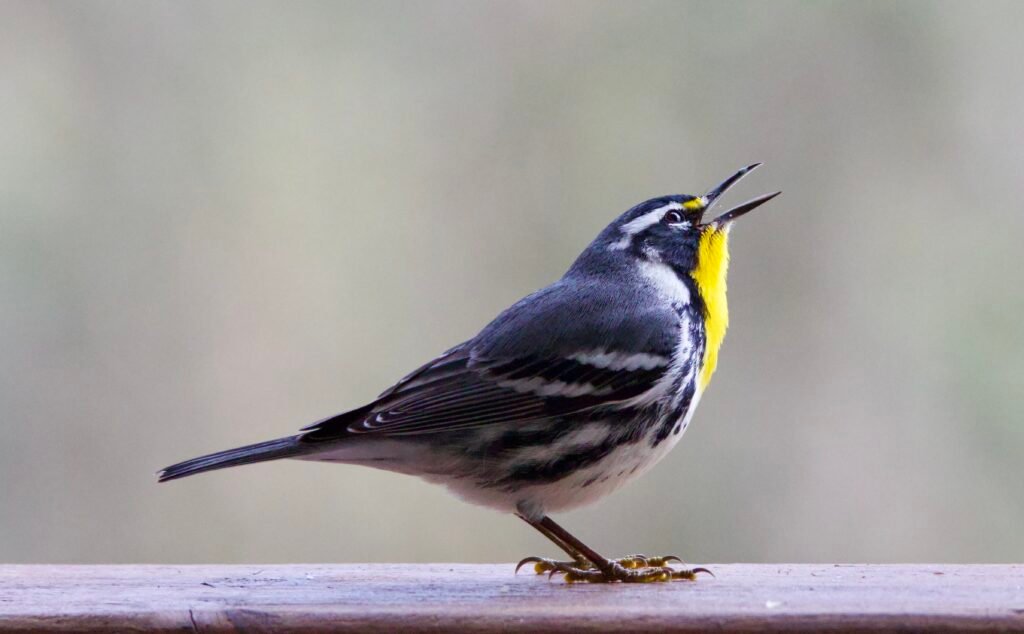
What are yellow-throated warblers?
Yellow-throated warblers (Setophaga dominica) are in the family Parulidae or New World warblers which includes 47 species in North America from ovenbirds (Seiurus aurocapilla) to American redstarts (Setophaga ruticilla) to prothonotory warblers (Protonotaria cítrea). New World warblers likely originated in Central America and are small active birds with short pointed bills ideal for capturing insects. Within Parulidae, yellow-throated warblers are in the genus Setophaga along 34 other species of warbler including those it may be found sharing habitat with in your southern garden like pine warblers (Setophaga pinus), yellow-rumped warblers (Setophaga coronata), and northern parulas (Setophaga americana). English naturalist William Swainson coined the Genus Setophaga in 1827 from Ancient Greek meaning “moth eating”. You might recognize William Swainson by the bird species named after him in North American such as the Swainson’s thrush (Catharus ustulatus) and Swainson’s warbler (Limnothlypis swainsonii).
Summary: Yellow-throated warbler
| Scientific name | Setophaga dominica |
| Timing | Year-round in coastal areas of Southeast |
| Habitat | Canopy in live oak, sycamore, cypress and pine tree forests |
| Food | Primarily insects |
| Feeders | Mealworms, suet, chipped sunflower |
Description
The yellow-throated warbler is a little over 5 inches long and weighs about 10 grams which is equivalent to the weight of about 4 pennies. Adults have a bright yellow throat, black and white face, gray head and back and mostly white underside. Females and young males are slightly lighter than adult males, but it’s a very subtle difference.
Warblers can be very confusing. While you may see other small birds with similar coloration, the yellow-throated warbler is the only one with yellow confined just to the throat area, a black and white face, and a gray back. To make things even more confusing, there are two other birds with “yellow throat” in their names that live in the southeast, common yellowthroats (Geothlypis thichas) and yellow-throated vireos (Vireo flavifrons). Whoever came up with these common names should apologize to all amateur birders for creating more angst when it comes to identifying an already challenging group of birds.
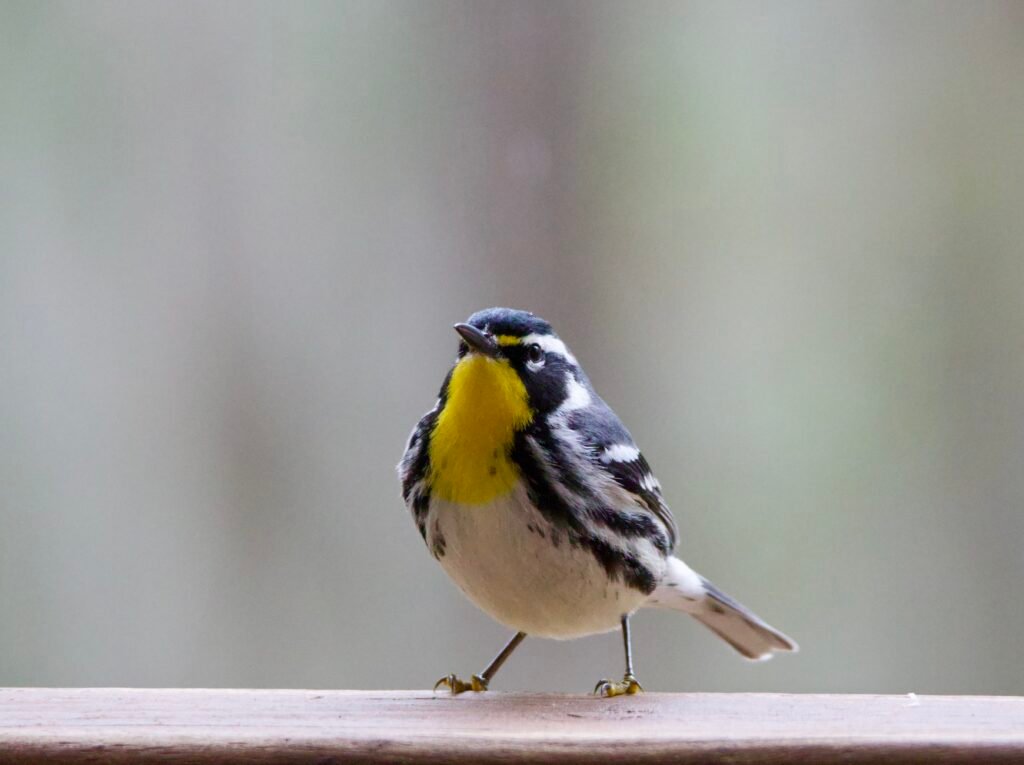
I’ll give you a little detail here about the other two “yellow throats” just so you’ll have context if you’re not familiar with them and it happens to come up with your cool new bird friends. Common yellowthroats are also warblers that have yellow throats, however, they have more yellow on their underside than yellow-throated warblers. They also have a more extensive black face mask, an olive-brown back and prefer to live in thick, shrubby habitats. Yellow-throated vireos have yellow that extends from their throats across their face forming bright yellow spectacles. They do not have black marking on their faces, and similar to most vireos, they have a shorter thicker bill than yellow-throated warblers. You’ll find yellow-throated vireos in the canopies of larger deciduous forests. As far as I know, neither of these species regularly comes to feeders.
Range
Yellow-throated warblers are a bird of the southeast, breeding primarily from Central Florida through the mid-Atlantic and west to eastern Texas and Missouri. After populations contracted in the late 1900s, yellow-throated warblers have begun to recolonizing the northern parts of their summer range with small populations nesting as far north as New York and Michigan. In the fall, yellow-throated warblers migrate south to winter in coastal areas of South Carolina, Georgia, Alabama, Mississippi and Texas, throughout Florida and the Caribbean, and parts of Central America. Many warblers migrate from breeding areas in the boreal forests of Canada to South America, so yellow-throated warblers have a very short migration by comparison, even remaining resident in some areas of the coastal southeast and Florida.
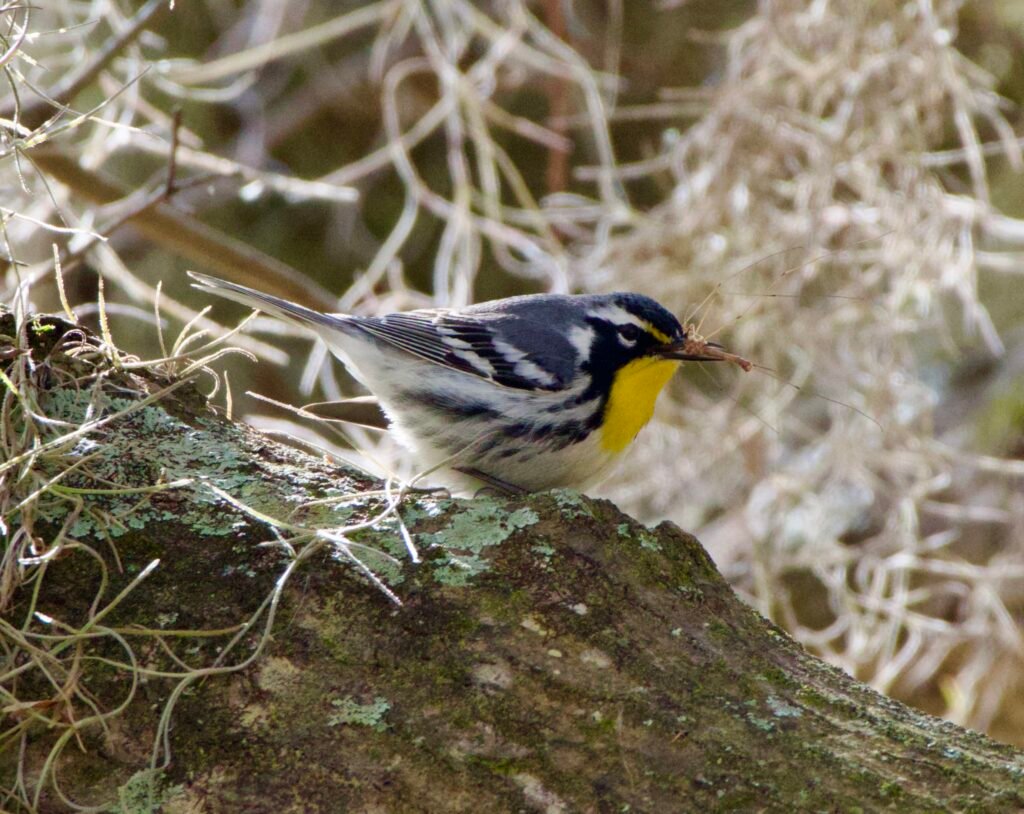
Diet
Like most warblers, yellow-throated warblers primarily eat insects, although there’s a really cool sighting of one eating a brown anole which is a type of lizard. This is a rare observation, but apparently folks have documented warblers eating vertebrates at least two dozen times. You can read more about these ambitious warblers here if interested.
Described as yellow-throated creepers by early English naturalist Mark Catesby, yellow-throated warblers tend to crawl and hop along branches in the tree canopy, probing the bark, leaves and Spanish moss with their long bills for bugs to eat. They can be found foraging in a variety of open woodland habitats with pine, sycamore, cypress, and live oak forests as some of their favorites.
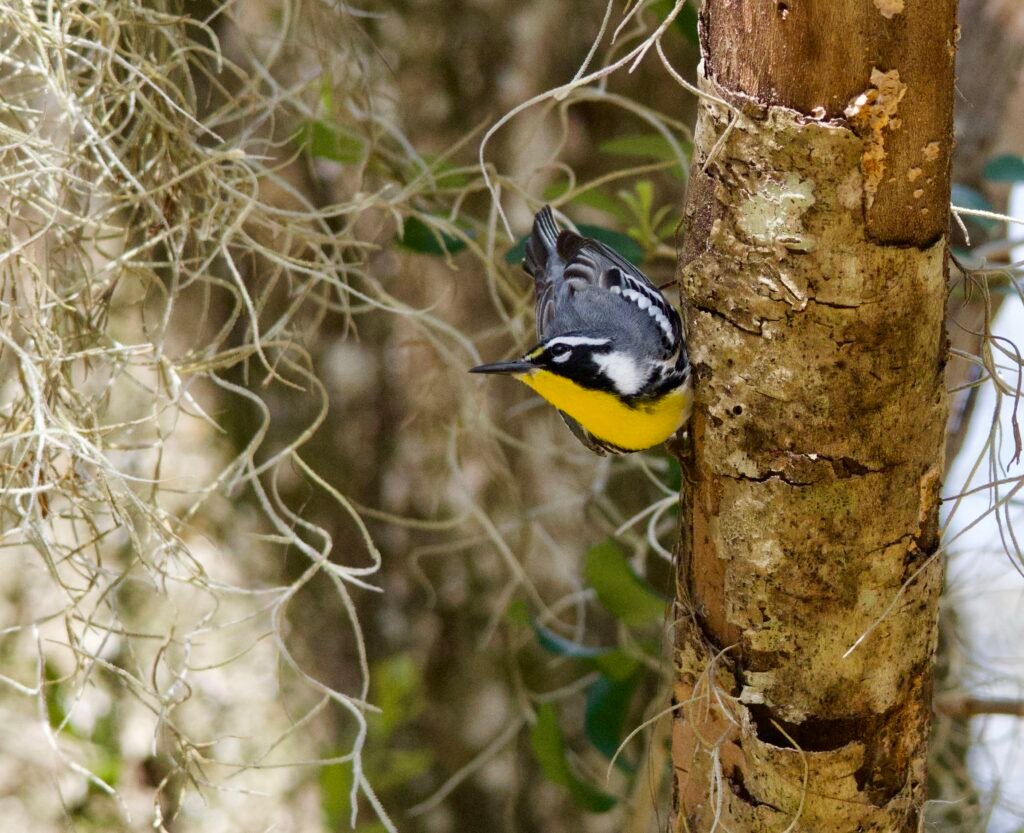
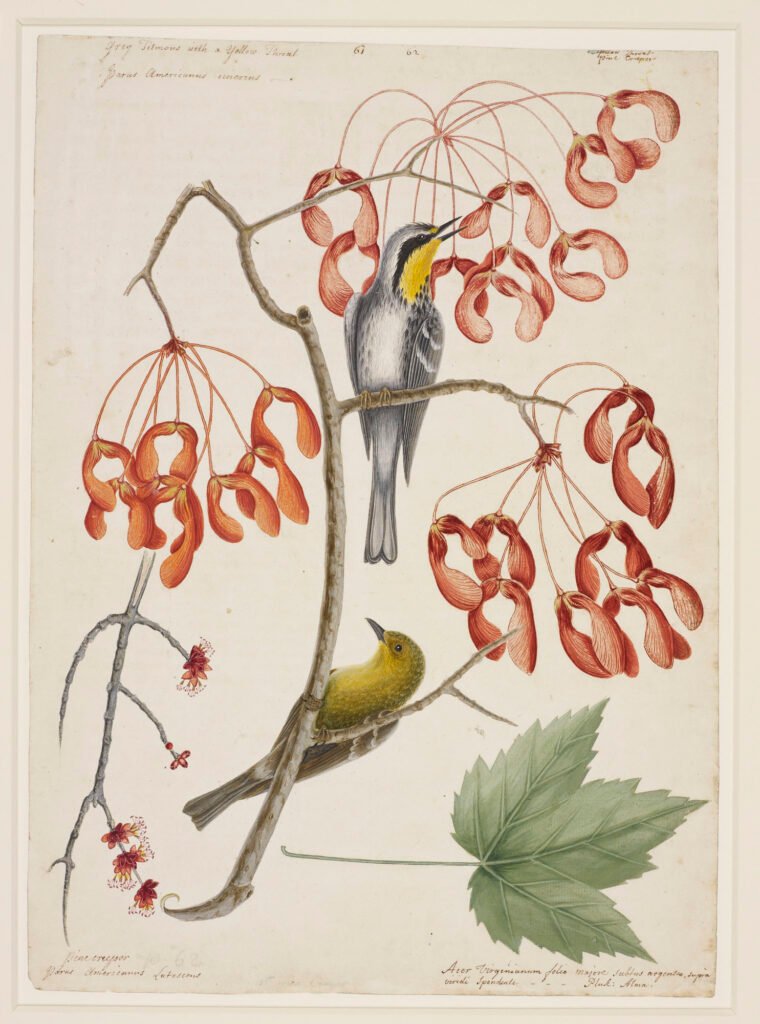
Breeding
Yellow-throated warblers arrive on breeding grounds early in the spring often before leaf out. Resident males in my yard will begin singing as early as mid February. Their sweet song is a melodic series of descending notes that rises abruptly at the end. By late March, females are busy building their cup-shaped nest in Spanish moss hanging from the branches of live oak trees towering over my garden. Spanish moss is neither from Spain nor a moss. It’s actually an epiphytic flowering plant in the bromeliad family. Where there’s no Spanish moss, yellow-throated warblers will construct nests at the outer ends of branches 30 to over 100 feet high in the canopy.
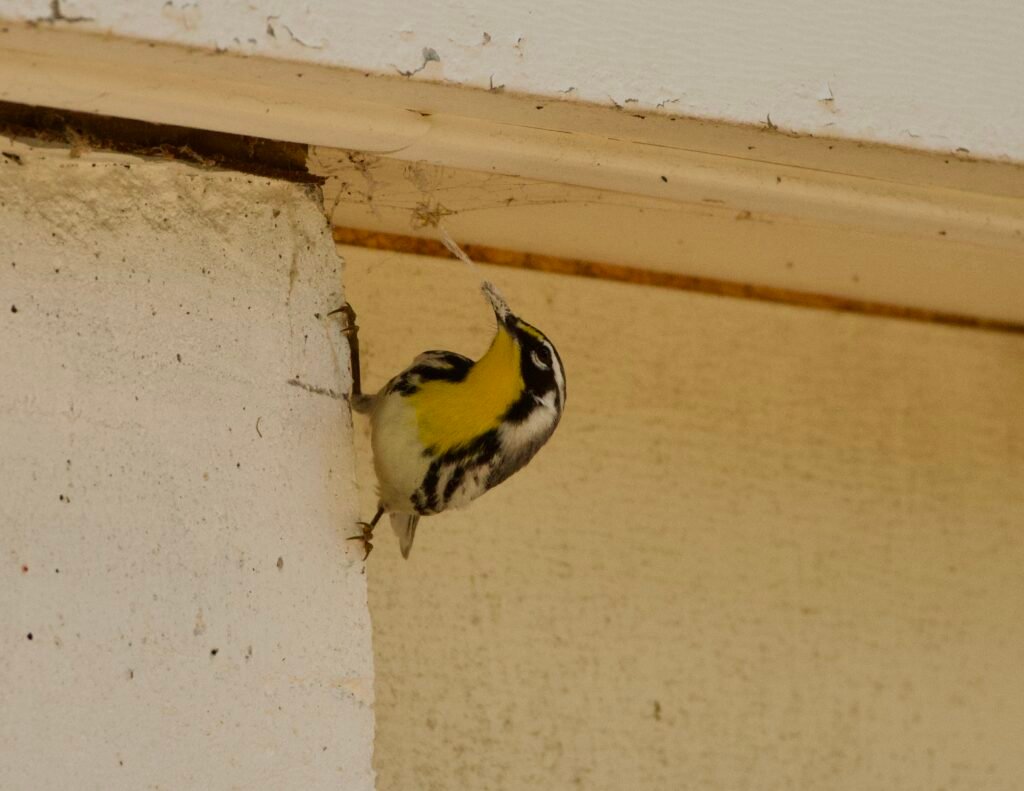
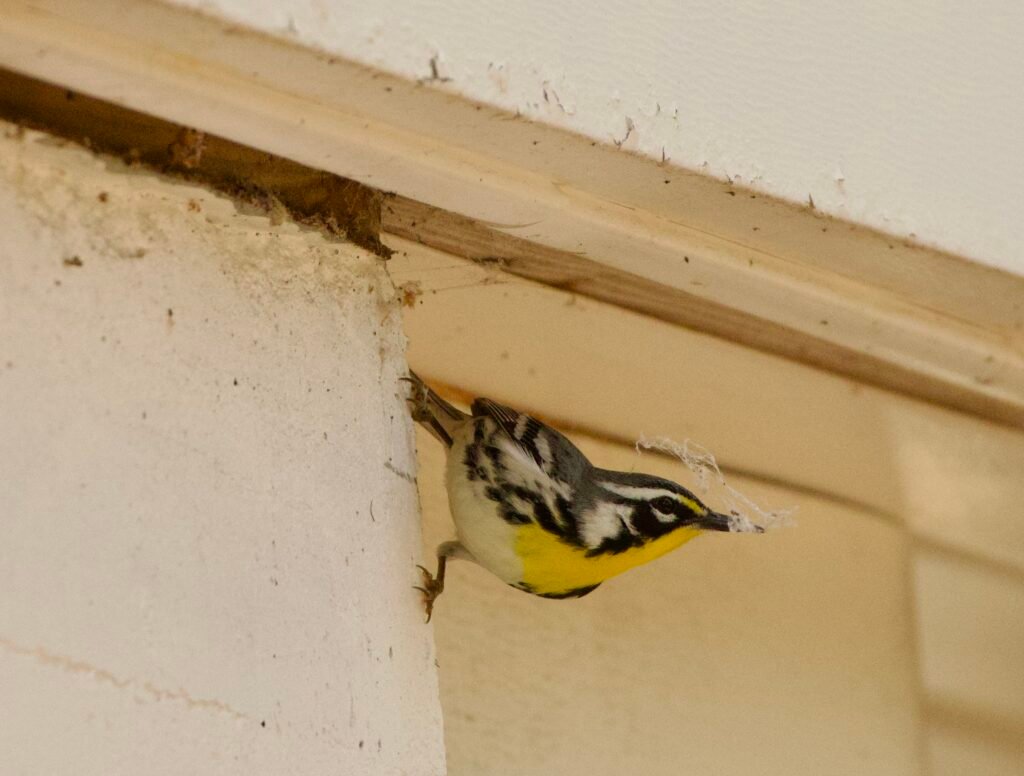
Females construct nests with grass, strips of bark, moss, weed stems and feathers. I watched a female yellow-throated warbler collecting spider webs off my house to add to her nest in a clump of Spanish moss. Once completed, she will lay 3 to 5 pale greenish speckled eggs. She may raise up to two broods each summer with the help of her mate.
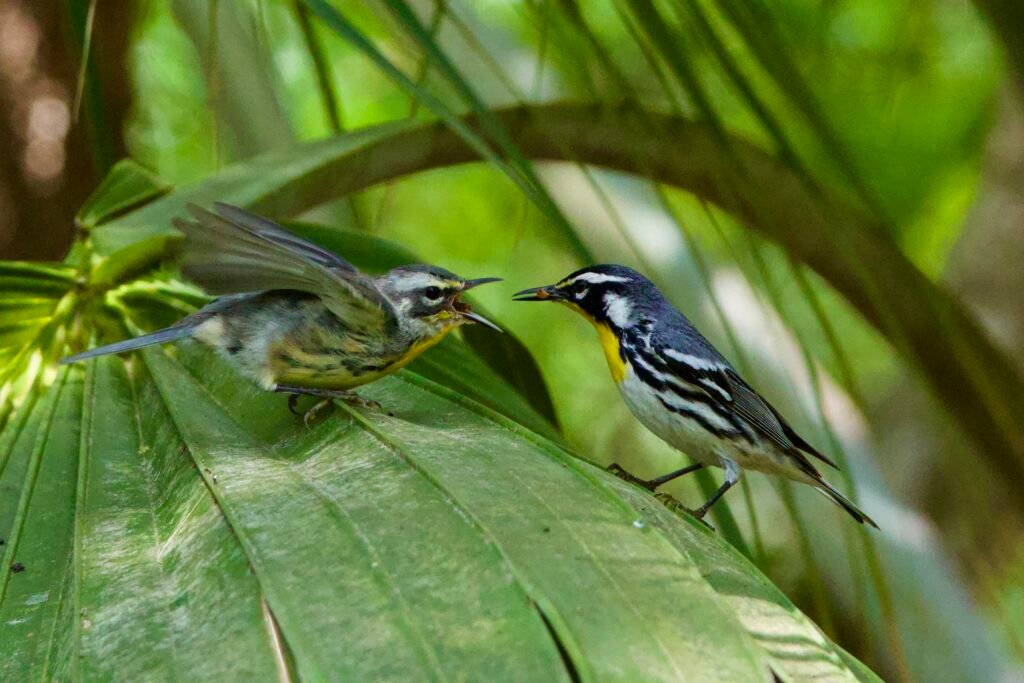
How to attract yellow-throated warblers?
I was really surprised the first time I saw yellow-throated warblers picking up pieces of chipped sunflower seed with their long slender pointed bill. It really didn’t seem right, like someone using tweezers to handle a sandwich. I didn’t find much online to suggest they came to feeders regularly. But mine kept coming back to awkwardly eat bits of seed they carefully selected from my dish feeders. Once I added suet and mealworms to the mix of offerings in my garden, they became regulars.
Habitat
While yellow-throated warblers will eat at feeders, they still depend primarily on insects to meet their energetic needs and raise young. Supporting insect populations by planting native trees and shrubs and limiting use of pesticides will make it more likely yellow-throated warblers will spend time in your garden and find your feeders. As mentioned earlier, yellow-throated warblers are usually observed foraging high in the canopy of trees. A study of forest birds in Mississippi found that a lack of good canopy cover limited the abundance of yellow-throated warblers. So having some tall trees in your yard will help attract yellow-throated warblers to your garden. They seem to prefer live oaks, sycamores, cypress and pine trees including loblolly and longleaf pines.
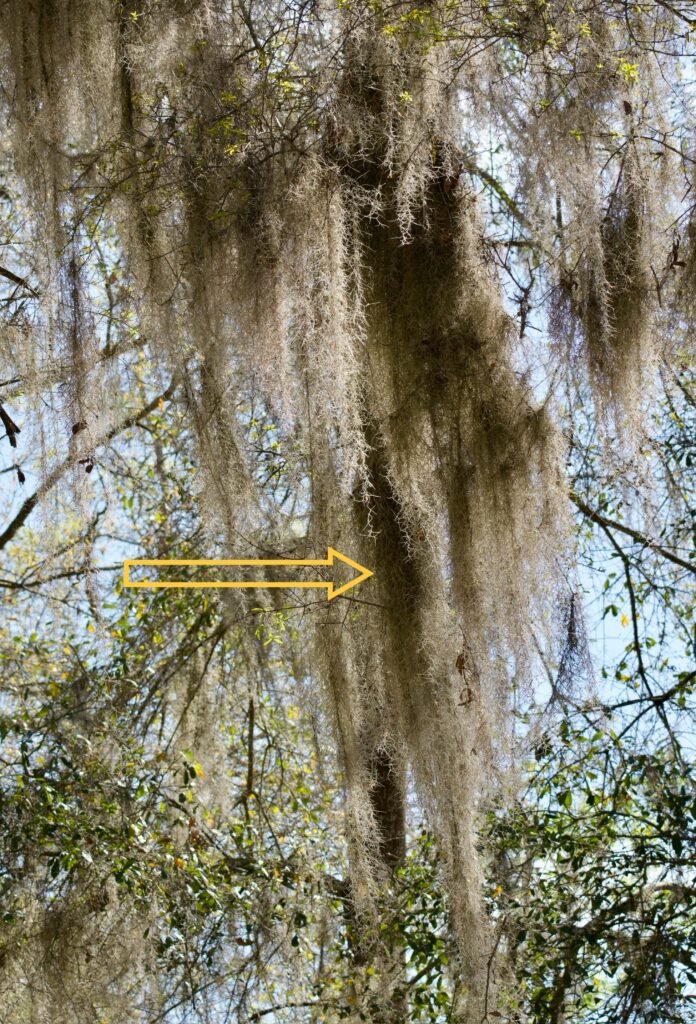
Live oaks
If you’ve got the space for a southern live oak tree (Quercus virginiana), you should definitely have one. With their sweeping branches festooned with Spanish moss and wide-spreading canopy, live oaks are iconically southern and a gorgeous addition to to anyone’s yard. Oak trees are also considered one of the most beneficial plants for wildlife in North America. Keystone trees that are host plants to over 400 butterfly and moth species, oaks also produce acorns that are important food source for a variety of mammals and birds including deer and turkeys. Yellow-throated warblers will enjoy foraging on the hundreds of caterpillar species your live oak harbors as well nesting in the Spanish moss hanging from its sprawling branches.
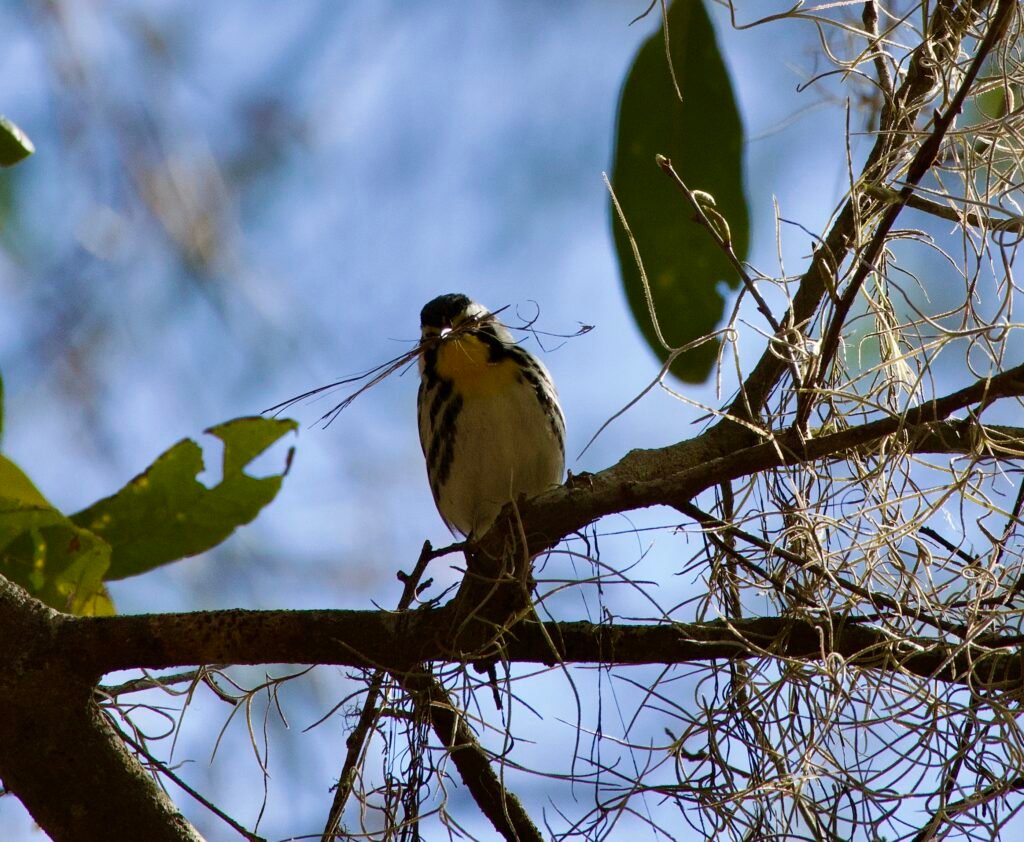
Live oaks are large, evergreen trees that may live over 200 years. They typically grow 40 to 80 feet tall with a canopy often wider than its height. Live oaks prefer the warmer climates of USDA zones 8-11 and should be planted in full sun or part shade. They are adaptable to many soil conditions as long as drainage is good and are drought tolerant once established. Live oaks are picturesque trees that will provide you with lots of shade on blazing hot summer afternoons and your yellow-throated warblers with a canopy to call home year-round.
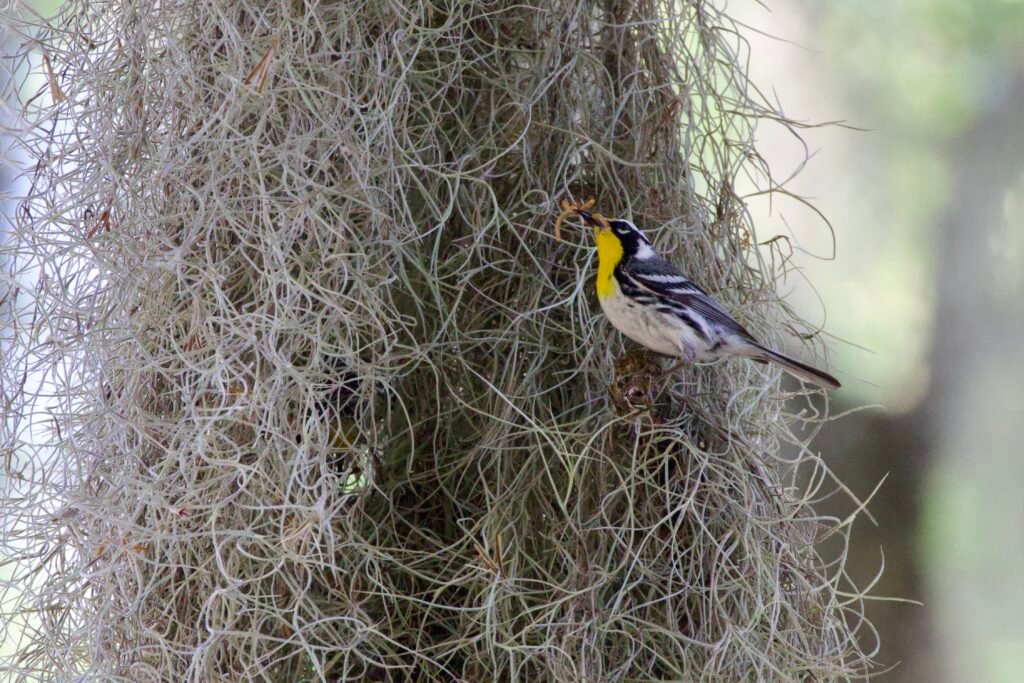
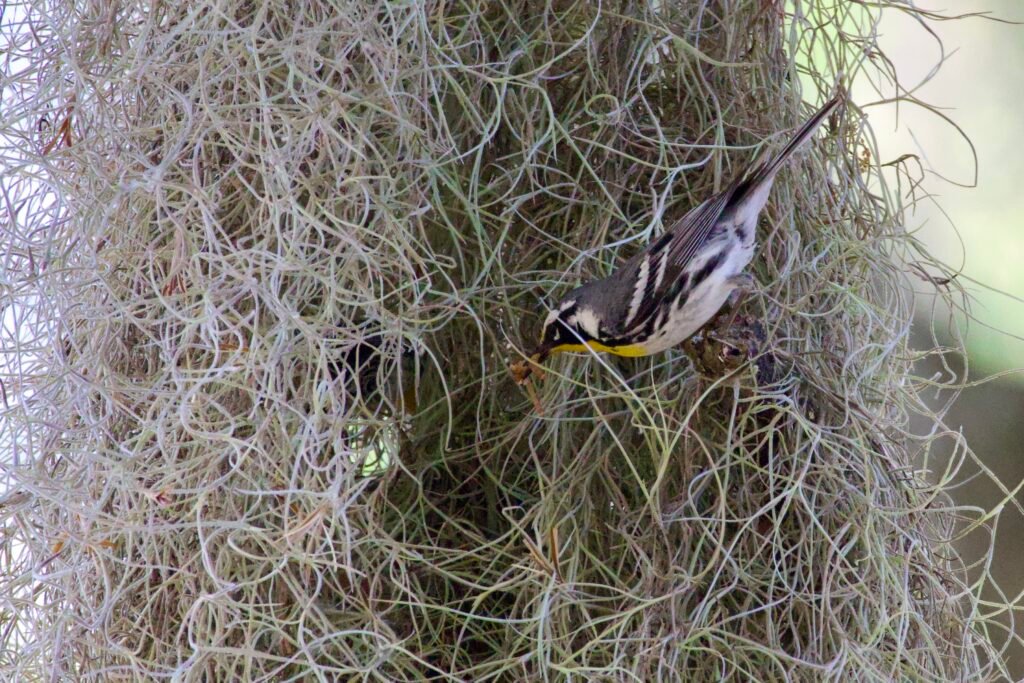
Yellow-throated warbler bringing food to the nest inside a clump of Spanish moss
Bird feeders
Mealworms
The yellow-throated warblers in my yard will readily eat chipped sunflower seed and suet but they are crazy for mealworms. I will watch them gobble down a dozen mealworms and wonder how that little bird could possibly stuff so many down in one sitting. If there are any worms left, you can be sure they will be back for more until they are left staring at an empty mealworm feeder with obvious longing. I prefer to offer live mealworms to my birds in either a small dome or glass feeder. Learn more about mealworms for wild birds in my article on the topic here.
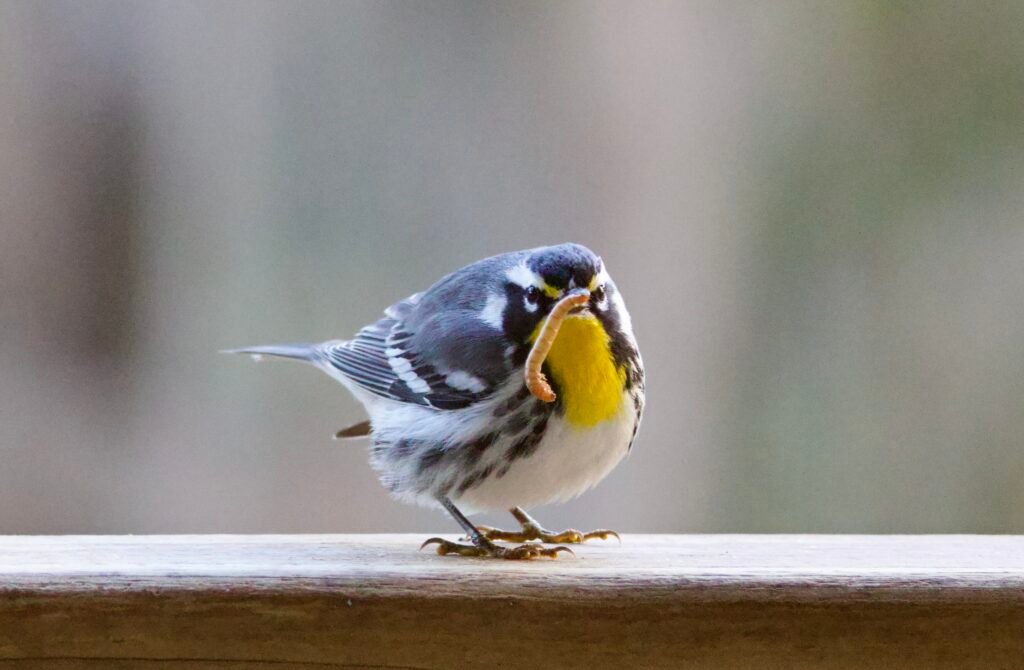

Suet
Once yellow-throated warblers give up on the hope of more mealworms, they will turn their attention to the suet feeder. I generally offer my birds suet either as a cake in a standard suet cage or a cylindrical block on a hanging feeder with a weather dome. My yellow-throated warblers don’t seem to have an issue eating the suet from either feeder and my impression is that any suet feeder you choose will likely work for them. All of my birds seem to be partial to the SuperSuet available at Wild Birds Unlimited. Its primary ingredients, peanuts, beef fat, mealworms, corn and other nuts, are all ground up into a homogenous block of suet that is seemingly irresistible to most birds. I’d recommend looking for something similar to entice your yellow-throated warblers.
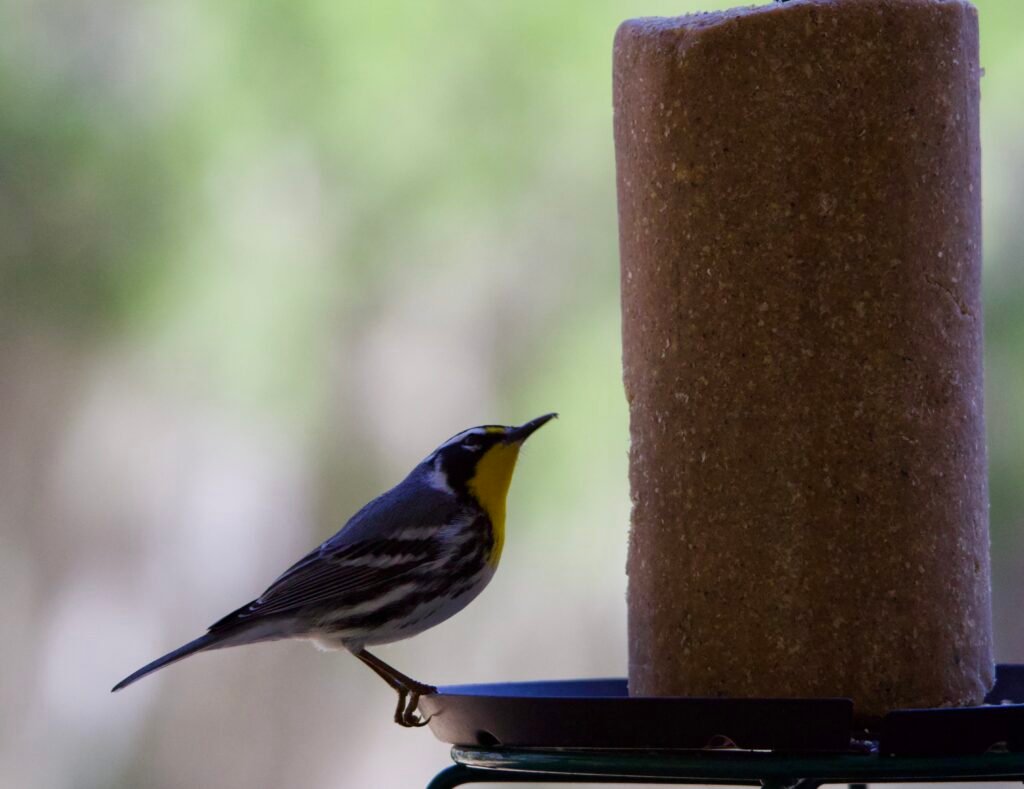
Chipped sunflower seed
Finally, I have only ever observed my yellow-throated warblers eating chipped sunflower seed, and have not seen them attempting to consume any other seed type at my feeders. I offer my chipped sunflower seed in small glass cups, but I imagine other feeder types would also work, especially small platform style feeders. I recommend a feeder filled solely with chipped sunflower seeds if you want to lure yellow-throated warblers. Other wild birds will appreciate the chipped sunflower seeds you offer, including American goldfinches, house finches, pine warblers, ruby-crowned kinglets and northern cardinals.
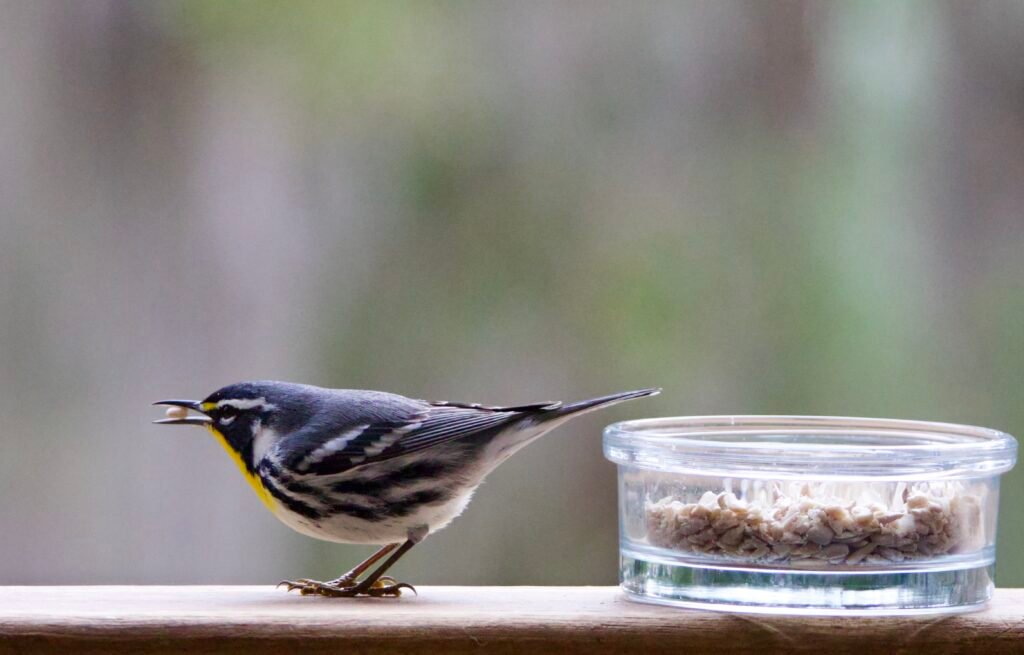
Other things to offer
Yellow-throated warblers will drink form bird baths. Providing clean water, especially on hot days, will draw birds to your garden.
I have observed my yellow-throated warblers collecting alpaca fur from nesting material balls I put out in the spring. Simply a sphere made of vines stuffed with cotton and fur, the nesting balls are used readily by Carolina chickadees, tufted titmice as well as the occasional yellow-throated warbler. You can purchase nesting balls or similar items online or at your favorite bird store, or make them yourself. Most of my birds prefer the alpaca fur which can also be purchased online.
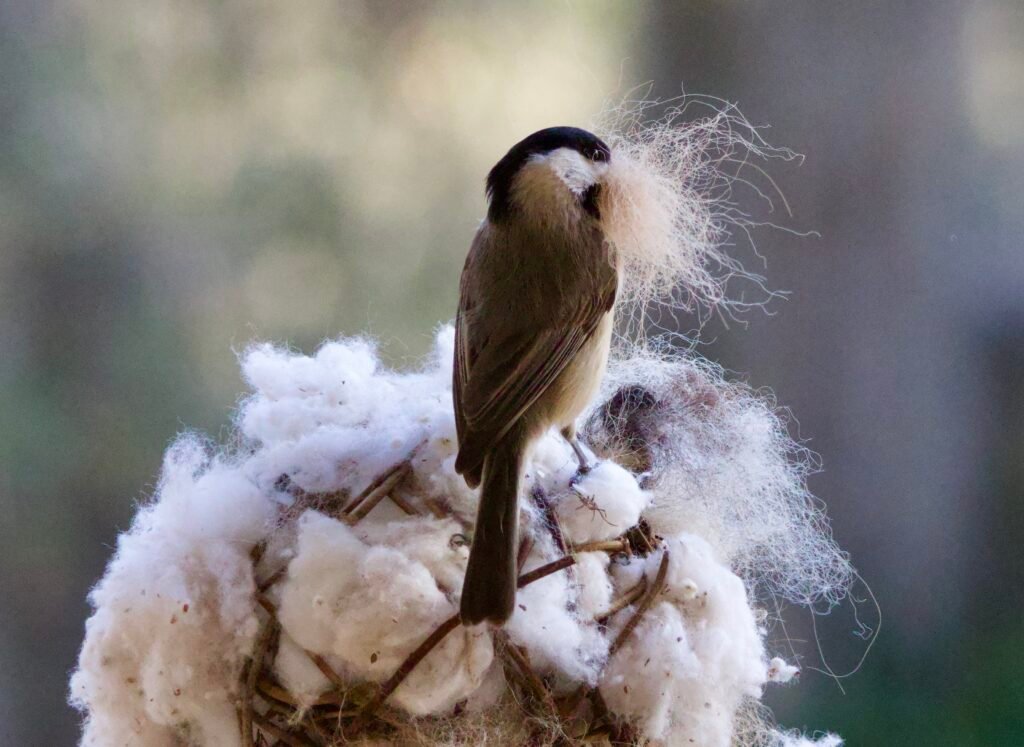
Want to learn more?
- All About Birds: Yellow-throated warbler
- Audubon Bird Guide: Yellow-throated warbler
- American Bird Conservancy. ABC’s Bird Library: Yellow-throated warbler
- Tennessee Wildlife Resources Agency: Yellow-throated Warbler, Setophaga dominica
- Outdoor Photography by Scott Simmon: Two Subspecies of Yellow-throated Warbler
- The condor 2008. Phenotypic Variation is Clinal in the Yellow-Throated Warbler by B. McKay
- Stokes Birding Blog: Yellow-throated Warbler, Get Out! By L. Stokes (Cool pictures of yellow-throated warbler eating a lizard)
- The Auk 1890. The Nesting of the Yellow-Throated Warbler at Raleigh, N. C. By C. S. Brimley
- The Wilson Bulletin 1974. Foraging of Pine Warblers Allopatric and Sympatric to Yellow-Throated Warblers by D. Morse
- Kansas Ornithological Society Bulletin 1996. Temporal and Spatial Relationships of Three Canopy-dwelling Warblers in a Missouri River Bottomland Forest by J.
- Evolution 1968. Competition and Character Displacement in Two Sympatric Pine-dwelling Warblers (Dendroica, Parulidae) by R. Ficken, M. Ficken and D. Morse
- The Passenger Pigeon 1991. Habitat Fragmentation and Forested Wetlands on the Upper Mississippi River: Potential Impacts on Forest-Ineterior Birds by J. Gretenberger
- Bulletin of Texas Ornithological Society 1996. Woodland Birds in Three Different Forest Types in Eastern Texas by Shakelford and Conner
- Swainson, W. 1827. A synopsis of the birds discovered in Mexico by W. Bullock, F. L. S., and H. S., Mr. William Bullock. Philos. Mag. (New Series) 1: 364–369, 433–442
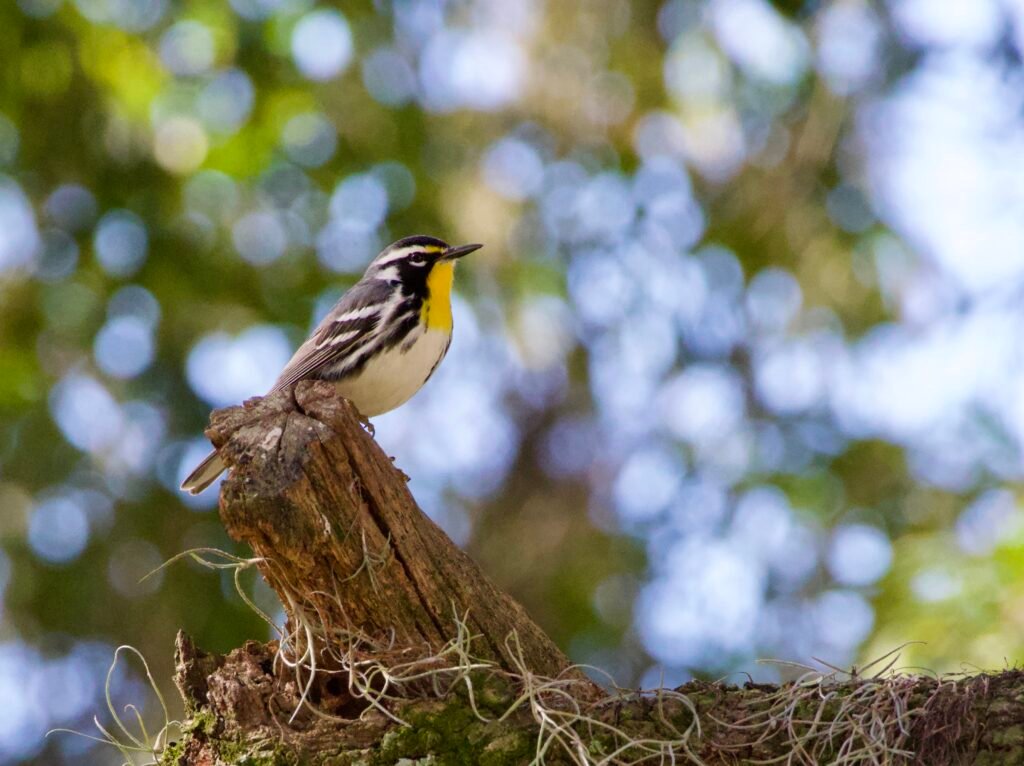
Fantastic article! Love the way you write 🙂
Pingback: Birding Basics: The Best Bird Feeder Setup for Beginners - The Southern Wild
What a fun and comprehensive article on yellow throated warblers. I love seeing them in my garden and at my feeders. AND they are easy to identify! Thanks for all the details about this endearing bird! Chuck
Pingback: How to Attract Carolina Chickadees - The Southern Wild